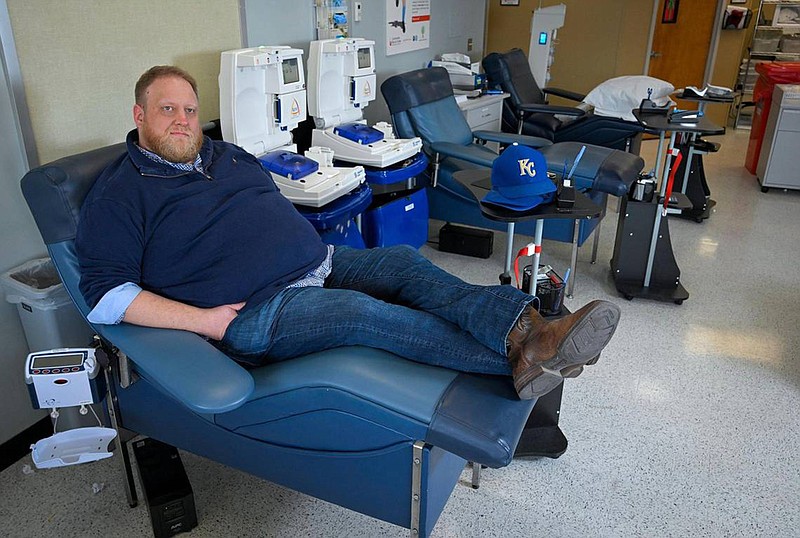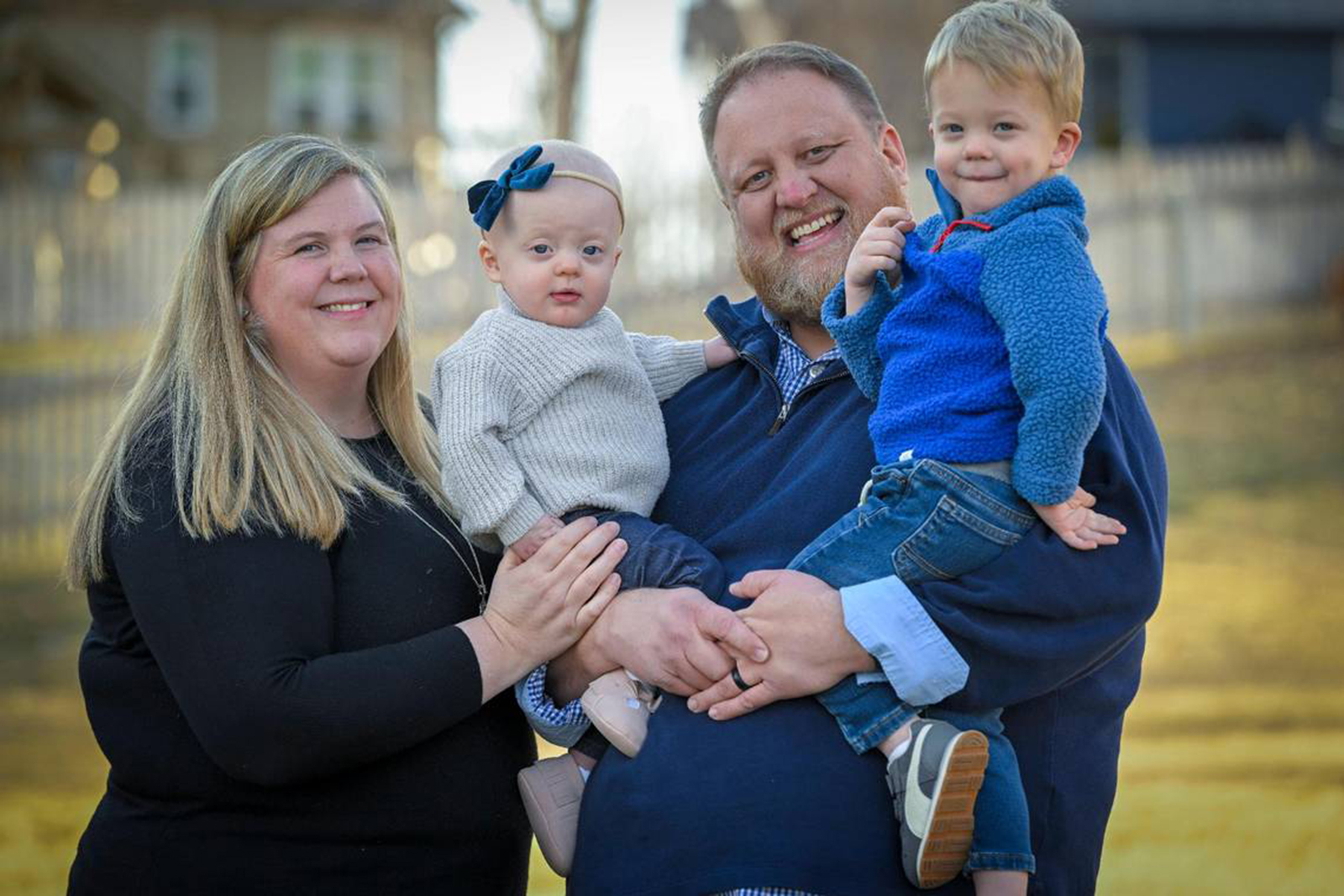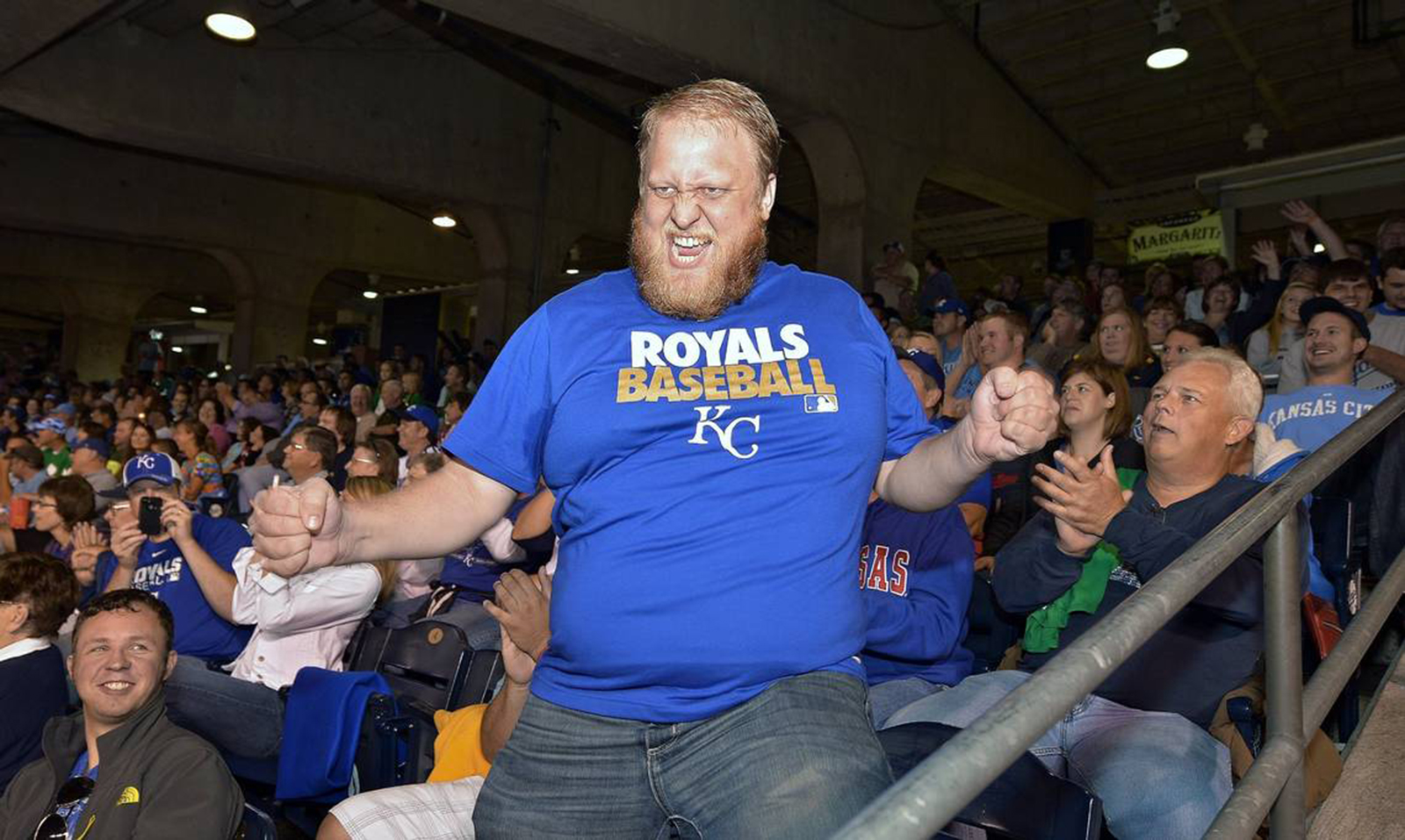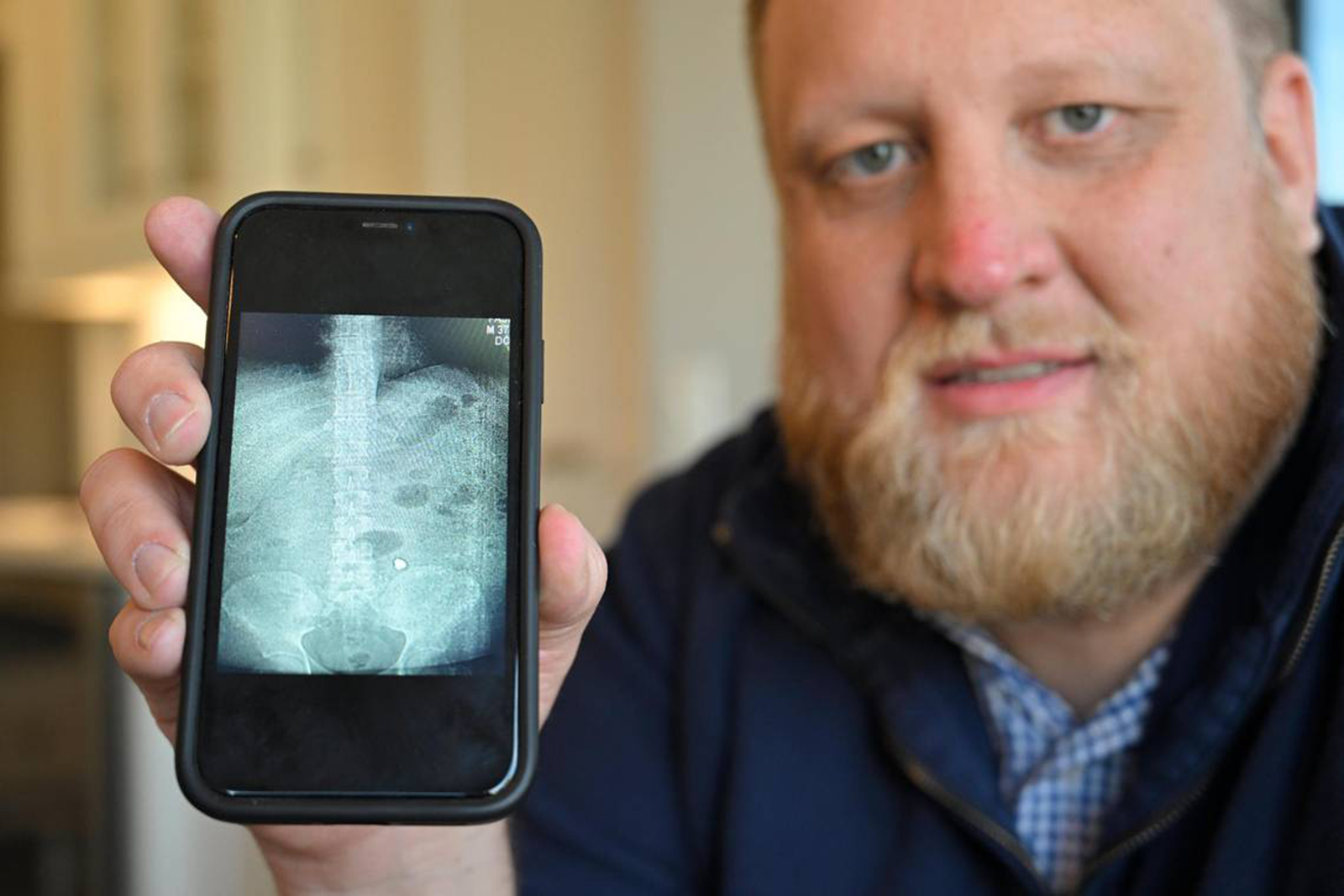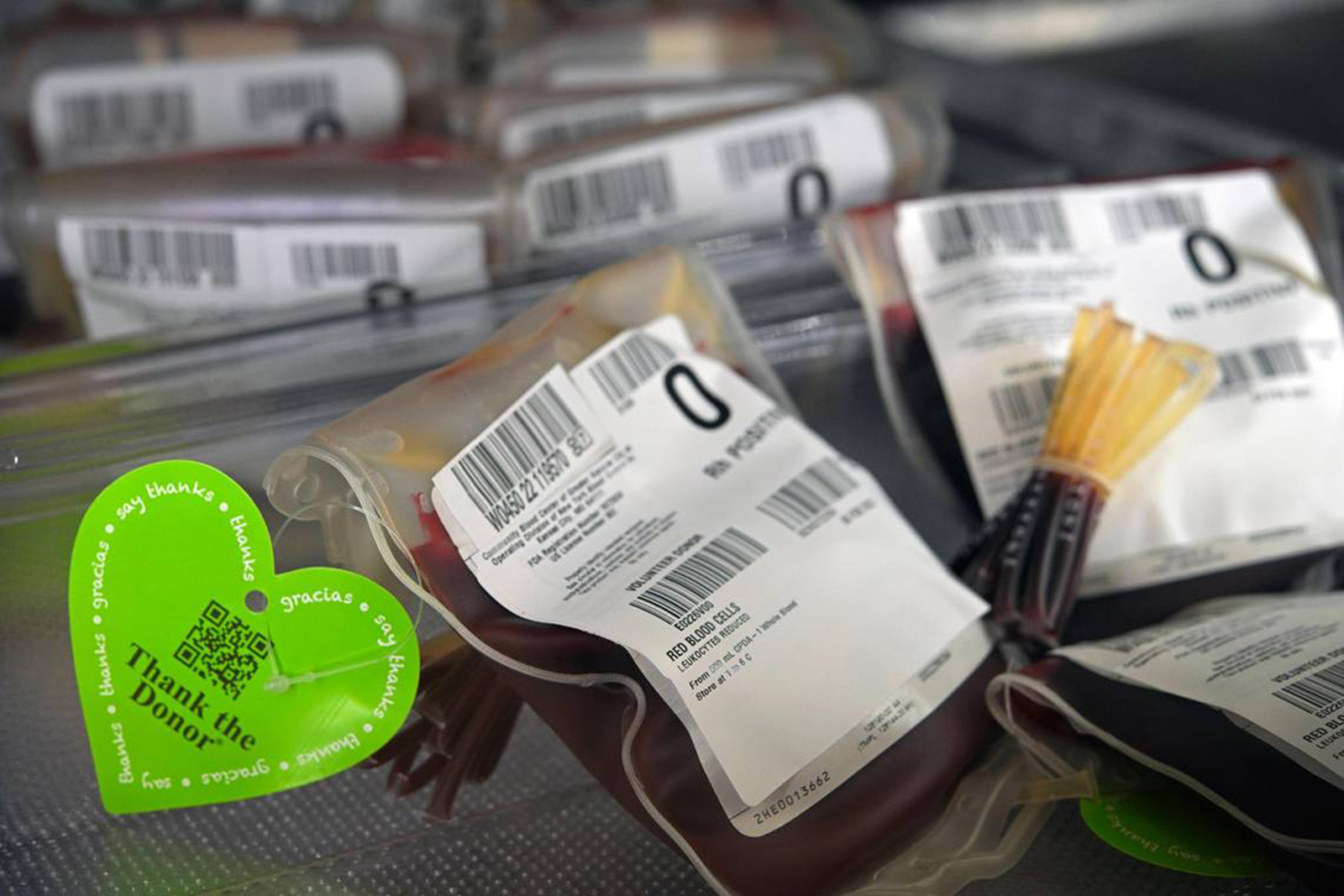KANSAS CITY -- Jimmy Faseler was already a little famous the night he almost died.
But when an intruder shot him in his home, the donated blood that saved his life brought him even greater fame.
That night in 2015, he had watched March Madness basketball with friends. Afterward, he walked up to his Independence, Missouri, house and knew right away something was wrong. Why were lights on with no one home? Why was the back door open?
He walked in and knew instantly what was happening. The place was trashed. The TV and stereo equipment: gone.
"I'm getting robbed!"
Suddenly, one of the burglars appeared in front of him. The two men locked eyes.
The burglar aimed a gun at him and fired into the body part that had made Faseler a celebrity.
Faseler yelled, "No-ooooooooo!"
A .44 caliber bullet tore into his belly, ripping intestines and blood vessels and severing nerves before it lodged above his left hip near his spine, where it lives today.
Faseler thought he was a dead man.
"This isn't my life," he thought. "This isn't who I am. This isn't how my life is supposed to end."
He managed to run out the back door as a second gunshot rang out. He collapsed on the deck. He remembers the blood, on his hands, soaking through his dress shirt as he called 911. He tried to stay calm.
But there was blood. Lots of blood.
"I have to keep my heart rate down," he thought. "I have to stay calm. Otherwise I'm going to bleed out and die before they find me."
It took blood and platelets from 28 people to save Faseler's life. In the years since, this Royals fan, who before was best known for shaking his belly on the Jumbotron at Kauffman Stadium, has built a life he thought he would never have, with a wife, two young children and a magazine-beautiful home in Shawnee.
Thanks to his mom leading blood drives at school, he had been a blood donor before the shooting. Now he's even more passionate about why people need to give.
"I do it all the time," Faseler told the Kansas City Star. "It's nothing compared to getting shot."
Kansas City's Community Blood Center needs more Jimmy Faselers as it tries to resolve a years-long shortage of blood exacerbated by the pandemic. The center is the primary blood supplier in Kansas City, serving more than 60 hospitals in Missouri and Kansas.
It's low on all blood types. Donations are down nationwide. Even though more than 60 percent of Americans are eligible to donate, only 3 percent do.
Earlier this month. the blood center called on local hospital leaders and elected officials to help publicize its second #GiveLifeKC public awareness campaign.
The campaign challenges Kansas Citians to donate blood every season in 2023, at least four times, and recruit others to do the same.
Worst-case scenarios concern Kansas City hospital leaders.
"When you're living on one or two days of supply, God forbid, we would have a big demand and we don't have enough blood," Dr. Mark Steele, chief clinical officer for University Health, told the Star.
"Thank goodness we've never gotten to that point. But we're sort of teetering on the brink."
He kept bleeding
It wasn't easy for Faseler to stay calm, bleeding out in the dark that night, scared he would get shot again and unable to remember his address for the 911 dispatcher. "Even then in the moment of being shot I knew how important it was for me to have blood in my body, not out of my body," he said.
Using his car key fob he blasted his car alarm so the police could find him. A neighbor called 911 too -- to complain about the blaring car alarm. When they arrived, officers pointed guns at Faseler, he said. Was he victim or perpetrator? He freaked out.
"I might get shot by the cops, too."
Faseler faded fast in the ambulance. He kept bleeding.
At Truman Medical Center, now University Health, the surgeon who operated on him told him later he received more blood than a typical body even contains. An adult who weighs 150 to 180 pounds has about 1.2 to 1.5 gallons of blood, or 10 units, according to the American Red Cross.
He had more of other people's blood in his body than his own, the surgeon told him.
The first media reports of the shooting didn't identify Faseler. But it didn't take long for social media to connect the dots, partly because Faseler's proud mother told the hospital staff that her son was that viral Royals fan -- the guy who does the "Bringing the Thunder" dance at the K.
15 minutes of fame
Faseler grew up in Nixa, Missouri, outside of Springfield, a small town that holds allegiances to the St. Louis Cardinals and the Kansas City Chiefs, depending on the sports season.
Faseler, though, born in 1985 a few months before the Royals beat the Cardinals to win their first World Series, always preferred the guys in blue and dreamed of being Bo Jackson some day.
He played football until middle school, then decided his heart was in theater -- because that's where the girls were. Being on stage got him hooked on the energy and adulation of an audience.
He loved performing, preferring comic antics over drama because "anyone can die on stage. Making somebody laugh actually takes skill."
He's perfected that skill. Faseler is quick with the laughs, even when the topic is his near-death. He works in auto parts sales and calls himself "Tommy Boy," the screw-up heir to a family auto parts company played by the late Chris Farley in the 1995 comedy.
After moving to Kansas City, he started going to Royals games, even though they kept losing.
When home crowds were thin it was easy to get his face on the Jumbotron. It became a game for him, and he got to be a regular on the big screen. He got good at it, shaking everything for the laughs.
No one paid much attention in 2009, 2010, those early years of catcher Salvador Perez's career with the Royals when Perez "looked like a little baby out there," Faseler laughed.
Then the media took notice in 2013, when Yahoo Sports declared: "The single finest gut in this country full of heaving flesh belongs to a man named Jimmy Faseler. Faseler stands 6-foot-2, weighs 300 pounds and needed only one beer to become famous."
Yahoo Sports called Faseler the star of a game that season when the Royals beat the Cleveland Indians, "a 28-year-old from nearby Independence, who is studying for his masters in counseling, works with at-risk youth and enjoys horrifying the masses with a helicoptering stomach that challenges the laws of physics and decorum."
The players noticed him, too. First baseman Eric Hosmer told Yahoo Sports, "We need to bring him back" next season.
After the last game of the 2013 season, Perez invited Faseler into the locker room and gave him his bat, now displayed in Faseler's sports-themed basement.
The Royals would later remember their "super fan" as he lay in a coma.
'Desperately single'
He figured the anesthesiologist at University Health could be the last voice he'd ever hear.
"I remember distinctly thinking, this might be the last thought I ever have. And it was kinda weird to think about: This is it," he said.
"And I started thinking, is this going to be my legacy? Did I do everything I wish I would have done? I don't have any kids. I don't have anything to show for ... you know."
He worried about his mother. His father had recently died unexpectedly. What if he died, too?
The surgeon sliced open his chest from his breastbone to below his belly button and repaired his insides. After surgery, doctors put Faseler in a coma for three days in a sterile room, his chest splayed open so they could watch for complications before stitching him up.
The bullet severed nerves, and he lost feeling in his left leg, making walking awkward. He's still regaining feeling today. Stairs can still be a struggle.
Sometimes Faseler forgets there's a bullet in his body. He's always reminded at airport security when he sets off alarms.
"Thankfully it isn't in my spine, otherwise I would have been paralyzed," he said. "It's still in there, just kind of hanging out."
As a busy trauma center, University Health depends on the Community Blood Center. About 1,300 patients each year benefit from receiving blood and blood products, Steele said. Many "wouldn't be alive today if it weren't for the incredible generosity and goodwill of those who donated the blood," he said.
But people like Faseler who undergo major surgery are not the only patients who need blood transfusions.
"You think about car accidents, people have broken bones, particularly big-bone fractures, broken pelvis, the femur ... you can bleed to death," Steele said. "And all kinds of medical conditions. Someone can bleed from an ulcer. Pregnant women can hemorrhage after they deliver. Obviously people undergoing surgery, if it's complicated. And even cancer patients, all the way to infants in neonatal."
Faseler's injuries were so severe he needed blood to replace what he had lost and blood platelets, the blood component that stops and prevents the body from bleeding.
He remembers waking from the coma and "being surrounded by people I really cared about and not being able to talk. Just being exhausted. And then I found out I had gotten another 15 minutes of fame.
"And it was really overwhelming. Because from my perspective, I went from 'this might be the last thought I ever have, I'm dying,' to people on Twitter wanting to send me DMs."
Some of those well wishes came from Royals players. Pitcher Danny Duffy had left several text messages. Hosmer recorded a get-well video.
As he recovered, Faseler would look out the window toward Children's Mercy across the street "and I would always wonder if my future wife works there.
"I was desperately single at the time. So there was this moment of, 'Hmmm, there's probably plenty of single women working in that building. I wonder if my wife's in there.' When you date in Kansas City, there's a 50-50 chance they either work at Cerner or Children's."
Turns out, she was there.
Three years after the shooting, Faseler left the single life behind when he married registered nurse Megan Davis, coordinator of liver transplants at Children's Mercy. They have a son who will be 3 in March and a 15-month-old daughter.
Both children have already been to their first Royals game.
Meeting his saviors
Faseler stayed in the hospital 10 days. But before he left, he talked to a social worker about what life would be like post-trauma. What came next turned out to be the hardest part.
He had been "paraded around" -- everyone from reporters to well-wishers wanted to see him in the hospital -- and had enjoyed the attention to a point. "Then I got discharged and there were cameras and TV crews videotaping me leaving the hospital going home, and then I got home, and that was it."
Silence.
Finally, it was time "to address the elephant in the room ... someone tried to kill me." Therapy helped.
Two years later in June 2017, 44-year-old Phillip A. Kisner of Independence pleaded guilty to charges of second-degree murder and first-degree assault for what happened that night in Faseler's home.
After Kisner shot Faseler, he shot and killed a 16-year-old accomplice, a boy who lived nearby who used to mow Faseler's lawn. Faseler knew the other accomplice, too, an 18-year-old who pleaded guilty to one count of burglary.
A year after the shooting, with the anniversary looming, Faseler decided to host a blood drive.
"Because how do you celebrate a one-year anniversary of getting shot," he said with a laugh. "... What kind of cake do you decorate? What's the color scheme? Do you invite the guy who shot you?"
He called the Community Blood Center and quickly found himself in meetings organizing an event that put him back in the headlines. The center arranged for him to meet eight of the 28 people whose blood saved his life.
He worried they would be disappointed when they met him. "Oh, I saved him," he said with a laugh.
He was stunned by their diversity -- of age, race, gender, religion. One man was deaf. Three men were Amish. Faseler had received a teenager's blood, too.
He didn't know their politics or whether they -- gasp! -- rooted for those New York Yankees. It didn't matter.
"The only real connection we had was some of their blood was in my veins and that was really poetic in some ways," he said.
"When you donate blood, you don't get to go, only people that vote for my political party get this blood. Or only people that worship in the same church that I worship in get this blood. Only people who have my skin color get this blood.
"You don't get to make those demands. It goes to anybody who needs it. And they could be a big piece of trash or they could be the nicest person in the world. It doesn't matter. Your blood still saved a life.
"And that's what really cool. It's a great equalizer. There's no pre-qualifier on who gets blood and who doesn't."
Like many people in the first days of the pandemic in March 2020, Faseler felt helpless, locked away from the world at home. Like many people, he wanted to do something.
Well, people still need blood, he figured.
So he donated and posted a selfie on Instagram to encourage others to do the same. In the photo, his face is covered with a blue Royals-themed mask, and he's wearing a red donor sticker on his jacket.
In recent months, Faseler's story of survival took an odd plot twist.
He has been diagnosed with hemochromatosis, "a disorder in which the body can build up too much iron in the skin, heart, liver, pancreas, pituitary gland, and joints," according to the Centers for Disease Control and Prevention.
Too much iron can be toxic, damaging tissues and organs and leading to other problems, including liver damage, diabetes and heart issues.
The treatment?
Faseler is under doctor's orders to donate blood to lower those dangerous iron levels.
He recently wrapped up three months of weekly donations. Now he's donating every eight weeks, unless his doctor next month tells him otherwise.
"In order for me to be healthy, I have to donate blood now," said the man walking around with a bullet in his body. "Talk about a world of irony."

